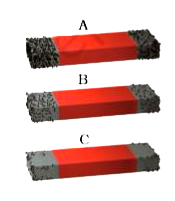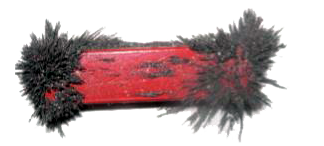A piece AB of the magnetite is dipped in a leap of small iron filings. It is observed that a cluster of iron filings stick to the ends A and B while there is practically no iron filing stick to its central region.
Answer the following questions
End B is called
Neutral Region
Pole
Both A & B
Equator
To answer the question regarding the ends A and B of the magnetite, we can follow these steps:
1. Understanding the Magnet: A piece of magnetite is a type of magnet that has two distinct ends known as poles. Each pole has a different magnetic property.
2. Observation of Iron Filings: When the magnetite is dipped in iron filings, the filings cluster at the ends A and B, indicating that these ends have a stronger magnetic force compared to the central region.
3. Identifying the Poles: The ends of the magnet are referred to as the "North Pole" and the "South Pole." In this case, we can denote end A as the North Pole and end B as the South Pole (or vice versa).
4. Conclusion: Since the question specifically asks about end B, we can conclude that end B is called the "South Pole."
Final Answer:
End B is called the South Pole.
---
End B is called the South Pole.
Topper's Solved these Questions
- MAGNETISMBOOK - BEIITIANSCHAPTER - MAGNETISMEXERCISE - Conceptive Worksheet
16 Videos
- MAGNETISMBOOK - BEIITIANSCHAPTER - MAGNETISMEXERCISE - Summative Worksheet
17 Videos
- LIGHT BOOK - BEIITIANSCHAPTER - LIGHT EXERCISE - IIT JEE WORKSHEET
1 Video
- MEASUREMENT BOOK - BEIITIANSCHAPTER - MEASUREMENT EXERCISE - IIT JEE WORKSHEET ( MATRIX MATCHING)
2 Videos
Similar Questions
A bar magnet is dipped in a leap of small iron filings. It is observed that a cluster of iron filings stick to the ends A and B while there is practically no iron filing stick to its central region.
Answer the following questions
End A is called
View SolutionA piece AB of the magnetitie is dipped in a leap of small iron filings. It is observed that a cluster of iron filings stick to the ends A and B while there is practically no iron filing stick to its central region.
End A is called
View Solution
Knowledge Check
Dipping a bar magnet into a box of iron filings results in a larger number of iron filings stick to the poles or ends than at the center portion because ________.
AOnly ends are dipped in the boxBThey are ends of a magnetCThey are easier to attach at the edges than at the centreDThe strength of the magnet is more at the polesDipping a bar magnet into a box of iron filings results in a larger number of iron filings stick to the poles or ends than at the center portion because ________.
AOnly ends are dipped in the boxBThey are ends of a magnetCThey are easier to attach at the edges than at the centre.DThe strength of the magnet is more at the polesA bar magnet is dipped in iron filings and taken out. Which of the following observations is correct?
AThe maximum quantity of filings gets sticked to the ends of the magnet.BThe maximum quantity of filings gets sticked to the middle.CThe filings gets uninformly distributed.DThe maximum quantity will be sticked at the north pole only.
A piece AB of the magnetitie is dipped in a leap of small iron filings. It is observed that a cluster of iron filings stick to the ends A and B while there is practically no iron filing stick to its central region.
End B is called
View SolutionA bar magnet is dipped in a leap of small iron filings. It is observed that a cluster of iron filings stick to the ends A and B while there is practically no iron filing stick to its central region.
Answer the following questions
The central region are called
View SolutionA piece AB of the magnetitie is dipped in a leap of small iron filings. It is observed that a cluster of iron filings stick to the ends A and B while there is practically no iron filing stick to its central region.
The central region or called
View SolutionThree magnets A, B and C were dipped one by one in a heap of iron filing. Fig. 13.3 shows the amount of the iron filing sticking to them.

The strength of these magnets will be
View SolutionBoojho dipped a bar magnet in a heap of iron filings and pulled it out. He found that iron filings got stuck to the magnet as shown in Fig. 13.4.
(i) Which regions of the magnet have more iron filings sticking to it?
(ii)What are these regions called?

View Solution